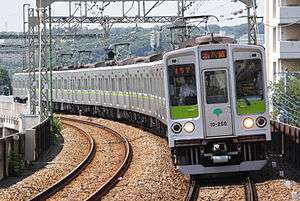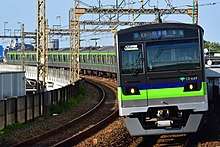Toei 10-000 series
| Toei 10-000 series | |
|---|---|
 7th-batch set 10-250 in June 2009 | |
| In service | December 1978 – February 2018 |
| Manufacturer | Alna Koki, Hitachi, Kawasaki Heavy Industries, Kinki Sharyo, Nippon Sharyo, Tokyu Car |
| Constructed | 1971–1997 |
| Entered service | 21 December 1978 |
| Refurbishment | 2009– |
| Number built | 224 vehicles (28 sets) |
| Number in service | None |
| Formation | 8 cars per set |
| Operator(s) | Toei Subway |
| Depot(s) | Oshima |
| Line(s) served | Toei Shinjuku Line, Keio Line, Keio Sagamihara Line |
| Specifications | |
| Car body construction | Stainless steel |
| Car length | 20,000 mm (65 ft 7 in) |
| Width | 2,800 mm (9 ft 2 in) |
| Doors | 4 pairs per side |
| Maximum speed | 120 km/h (75 mph) |
| Traction system | Chopper control |
| Acceleration | 3.3 km/h/s |
| Deceleration |
4.0 km/h/s (service) 4.5 km/h/s (emergency) |
| Electric system(s) | 1,500 V DC |
| Current collection method | Overhead wire |
| Safety system(s) | ATC |
| Track gauge | 1,372 mm (4 ft 6 in) |
The Toei 10-000 series (東京都交通局10-000形) is an electric multiple unit (EMU) train type that was operated by the Tokyo subway operator Tokyo Metropolitan Bureau of Transportation (Toei) on the Toei Shinjuku Line in Tokyo, Japan, from 1978 until 2018.
Operations
The 10-000 series operated on the Toei Shinjuku Line between Shinjuku and Motoyawata, and also on inter-running services over the Keio Line from Shinjuku as far as Hashimoto on the Keio Sagamihara Line.[1]
Formations
By April 2017, the fleet consisted of five eight-car sets (sets 10-240 to 10-280) with six motored (M) cars and two trailer (T) cars, formed as shown below, with car 1 at the Shinjuku end.[1]
| Car No. | 1 | 2 | 3 | 4 | 5 | 6 | 7 | 8 |
|---|---|---|---|---|---|---|---|---|
| Designation | Tc2 | M2' | M1 | M2 | M1 | M2 | M1 | Tc1 |
| Numbering | 10-xx9 | 10-xx8 | 10-xx7 | 10-xx6 | 10-xx5 | 10-xx2 | 10-xx1 | 10-xx0 |
- "xx" corresponds to the set number.
- Cars 3 and 7 were each fitted with two lozenge-type pantographs, and car 5 has one.[1]
Interior
Passenger accommodation consisted of longitudinal bench seating throughout. Wheelchair spaces were added when the original six-car sets were lengthened to eight-car sets.[2]
 Interior view of a prototype set in November 2004
Interior view of a prototype set in November 2004 Seating in October 2007
Seating in October 2007- Priority seat in October 2007
History
The prototype set, 10-010, was built in 1971, and initially tested on the Toei Mita Line.[3][4]
Refurbishment commenced in fiscal 2009. This consisted of adding external speakers, replacing the original roller blind destination indicators with LED indicators, moving the body side destination indicators from the ends to a central position, and adding interior passenger information displays.[2]
In 2005 and 2006, the 10-xx7 and 10-xx8 cars of sets 10-010 to 10-180 were refurbished and reformed with new driving cars to become 10-300R series. These cars were built between 1986 and 1989 as batches 3 and 5 to lengthen original 6-car sets to 8 cars, and so were still relatively new compared to the rest of the cars in the sets in which they were contained.[5]
The final set, 10-280, was retired on 11 February 2018.[6]
Build details
| Set No. | Batch | Delivery date | Manufacturer | Remarks |
|---|---|---|---|---|
| 10-010 | - | 26 November 1971 | Nippon Sharyo | Prototype, built as 4-car set. Lengthened to 6 cars in November 1978, and to 8 cars in October 1988. |
| 10-020 | 1 | 10 November 1978 | Tokyu Car | Initially built as 6-car sets. Lengthened to 8 cars with addition of 5th-batch cars between 1988 and 1989. |
| 10-030 | 10 November 1978 | Tokyu Car | ||
| 10-040 | 10 November 1978 | Tokyu Car | ||
| 10-050 | 10 November 1978 | Tokyu Car | ||
| 10-060 | 10 November 1978 | Tokyu Car | ||
| 10-070 | 10 November 1978 | Tokyu Car | ||
| 10-080 | 10 November 1978 | Tokyu Car | ||
| 10-090 | 10 November 1978 | Tokyu Car | ||
| 10-100 | 2 | 20 October 1979 | Nippon Sharyo | Initially built as 6-car sets. Lengthened to 8 cars with addition of 5th-batch cars in 1989 |
| 10-110 | 20 October 1979 | Nippon Sharyo | ||
| 10-120 | 20 October 1979 | Nippon Sharyo | Initially built as 6-car sets. Lengthened to 8 cars with addition of 3rd-batch cars in July 1986. | |
| 10-130 | 17 December 1979 | Nippon Sharyo | ||
| 10-140 | 17 December 1979 | Nippon Sharyo | ||
| 10-150 | 17 December 1979 | Nippon Sharyo | ||
| 10-160 | 17 December 1979 | Nippon Sharyo | ||
| 10-170 | 17 December 1979 | Nippon Sharyo | ||
| 10-180 | 17 December 1979 | Nippon Sharyo | ||
| 10-190 | 3 | 23 April 1986 | Hitachi | Air-conditioning fitted 1993-1995. |
| 10-200 | 20 May 1986 | Hitachi | ||
| 10-210 | 25 July 1986 | Hitachi | ||
| 10-220 | 4 | 10 May 1988 | Kinki Sharyo | |
| 10-230 | 24 May 1988 | Kinki Sharyo | ||
| 10-240 | 6 | 27 February 1989 | Kinki Sharyo | |
| 10-250 | 7 | 25 March 1992 | Kinki Sharyo | |
| 10-260 | 25 March 1992 | Kinki Sharyo | ||
| 10-270 | 8 | 12 December 1997 | Alna Koki | Lightweight stainless steel construction. |
| 10-280 | 12 December 1997 | Alna Koki |
The original six-car sets were later lengthened to eight cars with the addition of pairs of 3rd-batch (14 vehicles built in 1986 by Hitachi) and 5th-batch (22 vehicles built between 1988 and 1989 by Kawasaki Heavy Industries) cars.[5]
 Prototype set 10-010 in November 2004
Prototype set 10-010 in November 2004 1st-batch set 10-030 in July 2006
1st-batch set 10-030 in July 2006 3rd-batch set 10-190 in October 2009
3rd-batch set 10-190 in October 2009 Refurbished 4th-batch set 10-230 in August 2012
Refurbished 4th-batch set 10-230 in August 2012 6th-batch set 10-240 in May 2017
6th-batch set 10-240 in May 2017 7th-batch set 10-260 in October 2006
7th-batch set 10-260 in October 2006 8th-batch set 10-280 in February 2017
8th-batch set 10-280 in February 2017
References
| Wikimedia Commons has media related to Toei 10-000 series. |
- 1 2 3 私鉄車両編成表 2017 私鉄車両編成表 2017 [Private Railway Rolling Stock Formations - 2017] (in Japanese). Japan: Kotsu Shimbunsha. 25 July 2017. p. 32. ISBN 978-4-330-81317-2.
- 1 2 東京都営地下鉄 [Tokyo Toei Subway]. Japan Railfan Magazine (in Japanese). Vol. 52 no. 611. Japan: Koyusha Co., Ltd. March 2012. pp. 12–13.
- ↑ 日本の地下鉄 [Subways of Japan] (in Japanese). Japan: Ikaros Publishing. 20 April 2013. p. 15. ISBN 978-4-86320-701-1.
- ↑ The 地下鉄 [The Subway]. Japan: Sansuisha. 29 September 2004. p. 45. ISBN 978-4-06-366218-4.
- 1 2 3 Kajiwara, Hisashi (July 2009). 公営地下鉄在籍両数ビッグ3 東京都交通局 [Top 3 Subway Vehicle Owners: Toei]. Japan Railfan Magazine (in Japanese). Vol. 49 no. 579. Japan: Koyusha Co., Ltd. pp. 134–136.
- ↑ Konoda, Tsuneo (March 2018). 都営地下鉄新宿線の車両たち 後編 [Rolling Stock of the Toei Subway Shinjuku Line (Part 2)]. Japan Railfan Magazine (in Japanese). Vol. 58 no. 683. Japan: Koyusha Co., Ltd. p. 100-105.
